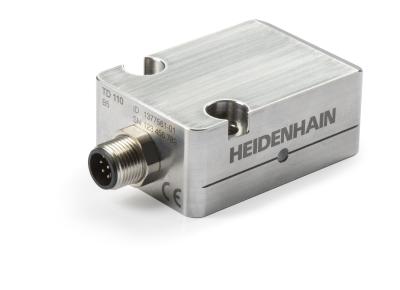
Specially designed for quickly sensing tool breakage during use within a machine tool,HEIDENHAIN CORPORATIONintroduces the new TD 110 Tool Breakage Detector. Providing contact-free inspection of drill bits and end mills, it can determine whether a tool is broken off by more than 2mm as it passes within a machine tool, yielding significant time and money savings.
The TD 110 tool breakage sensor can be placed in the work envelope so that it is fast and easy to reach during the tool change. The inductive sensor can detect tools as they pass by while they are spinning at their operational speed. Thanks to its rapid scanning technology, even very small tools made of HSS steel and carbide are detected.
The breakage sensor can then generate either a floating or an HTL switching signal and the machine control can evaluate it via standard instruction sets. These signals/outputs can be used to connect to a HEIDENHAIN TNC control or a PLC or to any other IOs of nearly every CNC control manufacturer. In addition, an LED signals whether a tool has been flagged.
Overall benefits of the HEIDENHAIN’s new TD 110 tool breakage detector include:
- Maintenance-free sensor for reducing non-productive time for breakage inspection.
- Cooling lubricant and lightly contaminated tools are tolerated.
- Universally retrofittable thanks to standard interfaces for tool touch probes.
Contact Details
Related Glossary Terms
- computer numerical control ( CNC)
computer numerical control ( CNC)
Microprocessor-based controller dedicated to a machine tool that permits the creation or modification of parts. Programmed numerical control activates the machine’s servos and spindle drives and controls the various machining operations. See DNC, direct numerical control; NC, numerical control.
- high-speed steels ( HSS)
high-speed steels ( HSS)
Available in two major types: tungsten high-speed steels (designated by letter T having tungsten as the principal alloying element) and molybdenum high-speed steels (designated by letter M having molybdenum as the principal alloying element). The type T high-speed steels containing cobalt have higher wear resistance and greater red (hot) hardness, withstanding cutting temperature up to 1,100º F (590º C). The type T steels are used to fabricate metalcutting tools (milling cutters, drills, reamers and taps), woodworking tools, various types of punches and dies, ball and roller bearings. The type M steels are used for cutting tools and various types of dies.
- work envelope
work envelope
Cube, sphere, cylinder or other physical space within which the cutting tool is capable of reaching.







